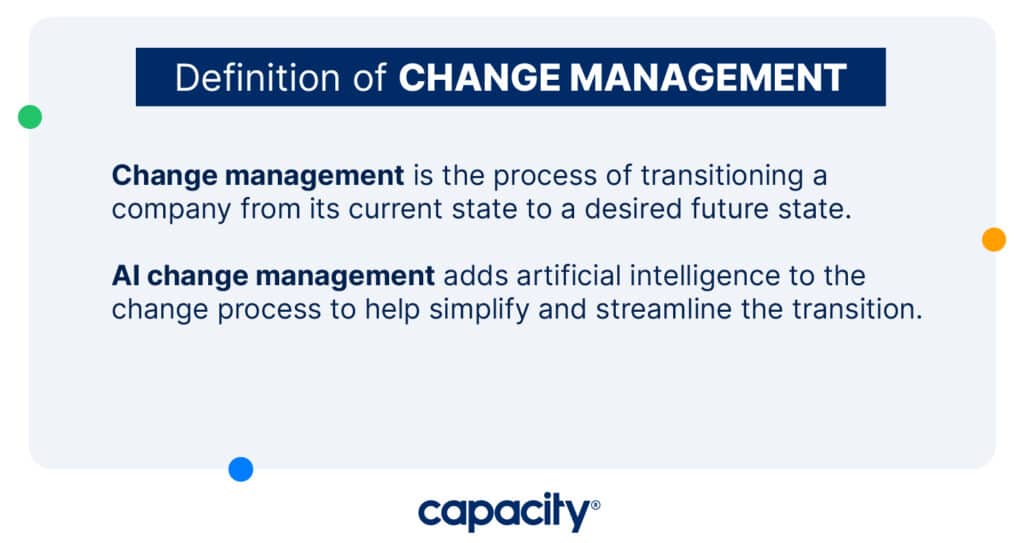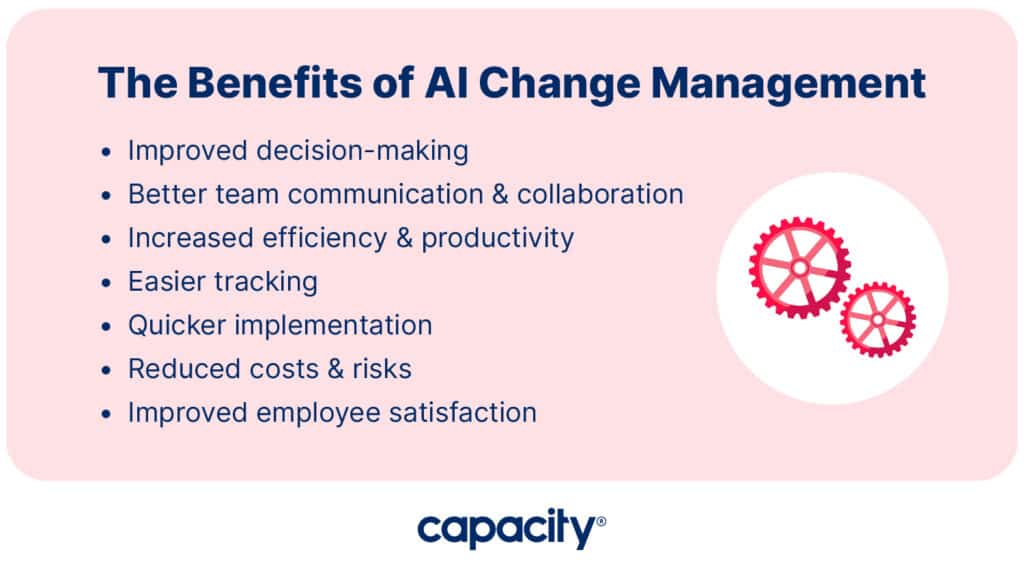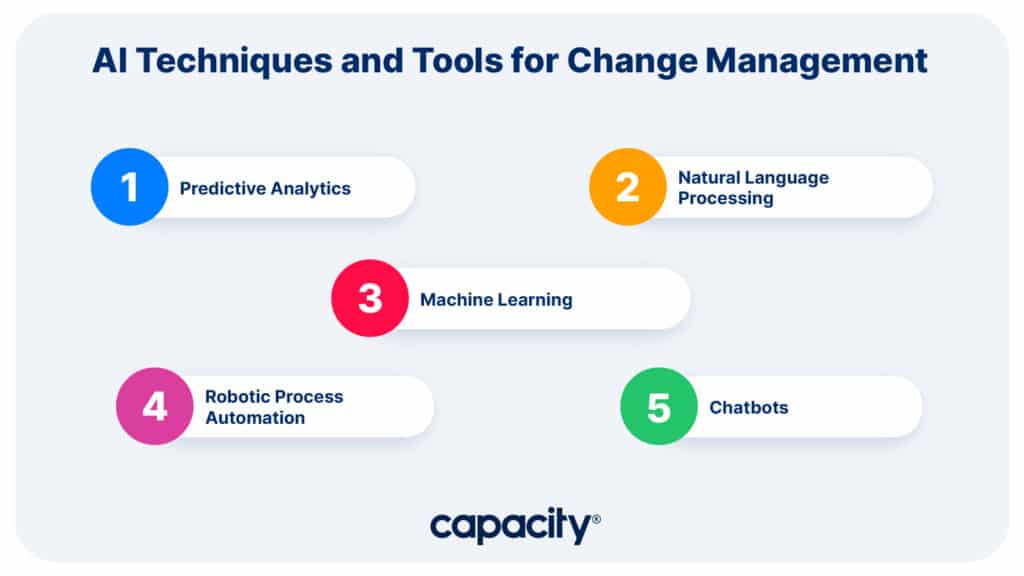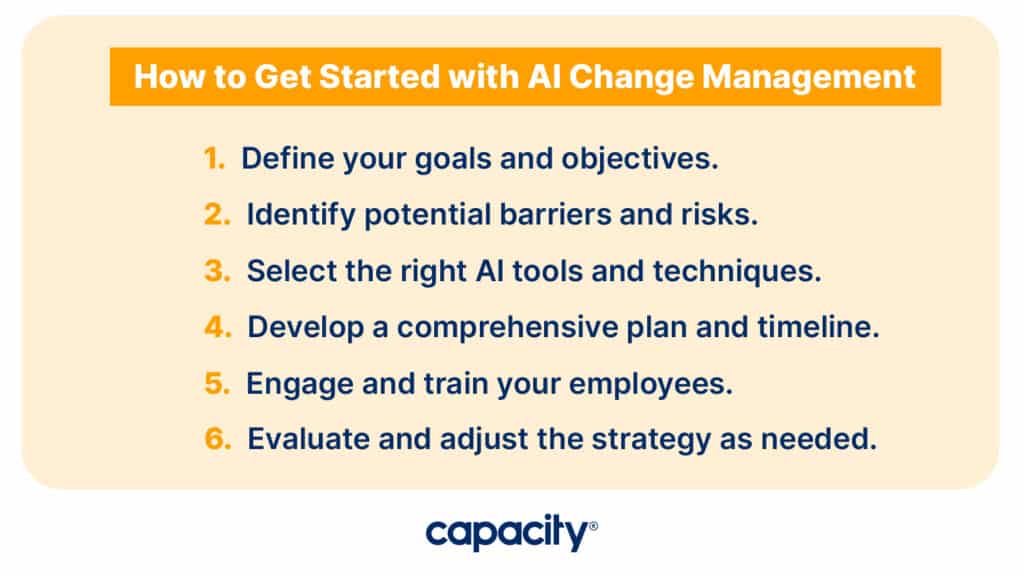The world of change management just got a high-tech upgrade – in the form of artificial intelligence. AI has infiltrated businesses in massive ways, from automated processes to predictive analytics. And now it’s ready to tackle the tricky task of guiding companies and employees through change. Forget sending lengthy memos or hosting dull town halls. AI can be your savvy sidekick to navigate changes with a human touch.
Adding AI to your change management can help you make data-driven decisions or create customized communication plans. And it can give you on-demand insight into the process and general team sentiment so you can make any adjustments to your strategy as fast as possible.

Automate Your Work
Capacity’s enterprise AI chatbot can help:
- Answer FAQs anytime, anywhere
- Find relevant documents within seconds
- Give surveys and collect feedback
While AI can enhance change management in powerful ways, human connection is still critical. The ideal solution is a blend of AI and human interaction. AI can tackle data mining and personalized messaging. And that frees up time for managers and leaders to spend on the human elements of change, like active listening, empathy, and motivation. AI enables humans, but it can’t (completely) replace them.
In this guide, you’ll get a full rundown on how to use AI change management and humans together for smooth transitions.
What is Change Management
Let’s start with level-setting. In this article, change management refers to the process of transitioning a company from its current state to a desired future state. It involves anticipating and managing changes in the workplace. That might include new technology, organizational restructuring, and process or system updates.
Change management involves creating a strategy for rolling out changes. And that strategy should include dedicated goals, a timeline, success criteria, a comms plan, and the tech you’ll use.

Understanding AI and Change Management
AI, or Artificial Intelligence, is a type of computer system designed to interpret data, learn from it, and make decisions. It can automate certain processes at scale, saving time and money for a business. It can also analyze large amounts of data quickly, providing insights that can be used to refine strategies.
AI can streamline the change management process by providing insights into how employees respond to the changes. What’s more, you can use AI to customize messaging. That way, different groups or individuals will have their needs and preferences met at scale.
The Benefits of AI Change Management
Adding AI to your change management process can provide several advantages. Here are a few:

Improved data analysis and decision-making
AI excels at crunching data to uncover insights that’d be almost impossible for humans to detect. By analyzing historical reactions to change and feedback, AI can help determine the best way to roll out changes. And it can predict how certain employees might respond. No more guessing games, just data-backed strategies.
Better team communication and collaboration
There’s no one-size-fits-all approach to change management, and AI gets that. Using personal information and past interactions, AI can craft tailored messages to specific groups or employees. That way, everyone receives communication about the changes in a relatable, relevant way.
Increased efficiency and productivity
AI streamlines the change process by automating mundane tasks like data entry or scheduling, freeing up resources. Those resources can then redirect their attention to things that need a human connection. For instance, AI can watch changes and alert managers when something is off. That lets them address issues in real-time, minimizing disruptions and preventing potential disasters.
Easier tracking and measurement
AI change management also simplifies the task of keeping tabs on changes. It can track progress, document results, and provide feedback in real-time for a smoother transition. This helps teams stay informed throughout the process so they can adjust their strategy accordingly if needed.
Quicker implementation
Change happens faster when AI and humans work together. AI can help identify issues, suggest solutions and put them into action quickly. That leads to a smoother transition with fewer hiccups along the way.
Reduced costs and risks
AI change management eliminates the need for manual data entry. And it provides a way to quickly pinpoint errors in a process or system update before it becomes a costly mistake. It also helps predict potential issues that might come up due to changes. That lets managers or teams address the issue immediately and make adjustments.
Improved employee engagement and satisfaction
During change management, timing is everything. AI can track employee sentiment in real-time and alert you to major issues or concerns as soon as they arise. By catching potential problems early, you can take a proactive approach to feedback. And you can adjust your strategy accordingly, improving overall satisfaction.
AI Techniques and Tools for Change Management

Predictive Analytics
One of the most common AI techniques in change management is predictive analytics. Predictive analytics uses machine learning algorithms to analyze data, detect patterns, and predict future outcomes. You can use it to ID potential risks and rewards of a change and then determine the optimal course of action.
Natural Language Processing
Natural language processing is another tool you can use to improve communication between employees, managers, and executives. It uses AI algorithms to interpret written or spoken language to understand what people are saying and how they feel. This knowledge helps organizations create targeted messaging and anticipate potential responses from employees.
Machine Learning
With machine learning, AI can learn from past data and predict future outcomes. It finds key trends and patterns from large amounts of data. And then it uses that information to inform decisions. You can use machine learning to predict the outcome of a proposed change. And you can note the potential risks associated with the transition.
Robotic Process Automation
Another tool in your automation toolbox is RPA. This AI-driven process automation can identify problems and suggest ways to improve them. And it can automate mundane tasks like data entry. That, of course, lets teams focus on the human elements of change.
Chatbots
You can use chatbots to quickly and accurately communicate changes to employees across the organization, so there’s one source of truth. Chatbots can answer employee questions about new policies or procedures. Or, they can provide clarification on team objectives. They can also address issues if they arise.
How to Get Started with AI Change Management
Ready to get started? Here’s how to roll out AI change management in your business:

Define your goals and objectives
Start by identifying the areas for improvement. Take a look at your current change process and see if there are any spots you could use AI technology. This could include automating certain tasks or analyzing data on employee engagement. Then, figure out which departments or teams might be affected by the changes.
Next, write out your goals and establish how you’ll track them so the whole org can align behind them. Some things to watch might be employee engagement and satisfaction, eNPS, time and cost savings, and employee productivity.
Identify potential barriers and risks
As you get started, note any potential barriers or risks associated with your AI change management strategy. This could include security concerns, data privacy issues, costs, or cultural differences that might arise with implementing a new system. Documenting all these considerations will help you decide if AI is the best option for your business.
It’s also important to remember that AI is still a relatively new technology, and it can be tough to determine the best way to use it for your organization.
Select the right AI tools and techniques
As you look at different tools and techniques, keep your company’s goals at the top of your mind. Whether you need a chatbot, a general knowledge base for data entry, a helpdesk to streamline answering questions, or all three (humble brag: that’s what we do…), you’ll need to see what fits your goals.
Then, as you explore tech, determine whether the platform is scalable. Does it provide real-time insights and analytics? How reliable is the tool? Take a look at the full checklist here for a comprehensive review.
Develop a comprehensive plan and timeline
A reasonable plan and timeline to roll out AI change management will depend on the size and scope of your changes. Generally, starting with a pilot program to test different AI tools and techniques is best. This way, you can gather feedback and refine the process before rolling it out to the whole company.
When developing your plan, also include training sessions for employees or managers on how to use the AI tools. Make sure that everyone understands what’s expected of them and how the changes might impact their day-to-day tasks.
Also, consider any potential challenges or disruptions you may face during the change management process. This could include staff resistance or unexpected issues stemming from technology or policy changes. Have a plan to watch and respond to these issues quickly so the transition can remain on track.
Engage and train your employees
Start by educating your employees. It’s essential to make sure all your employees have a clear rundown of the basics of AI change management and how you’ll use it in your organization. This might include workshops, webinars, educational videos, tutorials, or in-person training sessions. These trainings should cover topics like understanding the data gathered, its use, and how AI will be integrated into their workflows.
Evaluate and adjust the strategy as needed
After you’ve rolled out AI in your change management process, keep an eye on any changes in your employee engagement or sentiment. This will help you determine whether the technology is working or if some shifts are needed.
AI change management can be a powerful tool for streamlining and improving the process of transitioning to a new state or introducing changes in the workplace. While it’s important to remember that AI can’t replace human interaction, it can be valuable in driving change and ensuring success. So, if you’re looking for ways to make your change management process more efficient and effective, consider incorporating AI technology.
Ready to bring AI tech to your team? Try Capacity out for free today!





